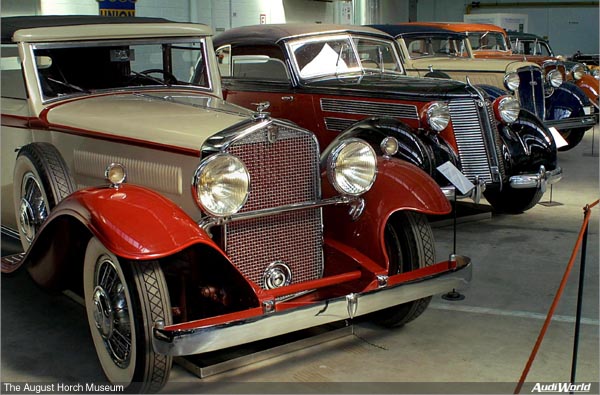The August Horch Museum Moves to a Worthy Venue

“We have been working toward this day for a long time – and I think we can be proud of the result.” Rudolf Vollnhals, Director of the August Horch Museum Zwickau GmbH, is looking forward to September 10th 2004, when the museum will finally open in a fitting venue: the birthplace of Audi – the original factory where August Horch established the Audi Automobilwerke GmbH in 1910, on the road formerly known as Walter Rathenau Strasse in Zwickau, now renamed Audi Strasse. Numerous guests of honour have been invited to the opening ceremony, including the President of the Free State of Saxony, Prof. Dr. Georg Milbradt and Audi’s CEO Prof. Dr. Martin Winterkorn. Building work has taken two years and cost nine million Euro. AUDI AG, which together with the town of Zwickau is an equal partner in this non-profit making company, committed 6.6 million Euro to the project. The purpose of the company, which was established in 2000, is to run the museum and document automobile construction in Zwickau, where August Horch started to build his cars exactly 100 years ago. The museum’s collection includes some very unusual and even unique exhibits connected with early automobile construction. The story of the August Horch Museum began in 1988 during the GDR era, when a small exhibition was set up in a former dining hall in the Sachsenring factory – in part of the plant that used to house the Audi factory. Although VEB Sachsenring went into liquidation following German reunification, the historic collection survived and was maintained by means of financial grants. The historic building, however, was in such a poor state and the available money so limited that only a significant commitment from business and industry could secure the museum’s future. AUDI AG saw it as its duty to take action with a view to preserving the company’s historic roots. The exhibition area was extensively redesigned and extended (to 2500 square metres). By lowering the floor in the basement, it was also possible to increase the height of the rooms. The installation of large windows improved the appearance of this area. The museum’s designers had another special idea too for this section: a simulation of the original Leipziger Strasse dating from the Zwickau of the 1930s was constructed so that vehicles from this era could be parked in front of this façade. For visitors, the permanent exhibition starts on the upper floor with the luxury Horch and Audi models. The particular highlights in this section are the 1936 Union Type C racing car and the 1914 Audi Type C in which August Horch won the Alpine Rally, the toughest event of its kind in the world at that time. In addition, there is the last surviving 1916 Horch 25-42 hp truck and the chassis of a 1927 Audi Type M. Another very unusual exhibit is one of the oldest Horch engines – the first 14-17 hp four cylinder engine from 1904. The oldest vehicle in the exhibition is a Horch 12-28 Phaeton dating from 1911. There are also some special set pieces, such as an exact reproduction of an Auto Union AG German Motor Show stand from the 1930s and a historic filling station. However, the exhibits are not only from the pre-war era. There are six rooms in the basement documenting the history of the Trabant. The exhibition also contains examples of a popular GDR export, the H3A truck, and a 1969 “Repräsentant” built to carry guests on state occasions. The most modern exhibits are the VW Polo and the one millionth Passat – in both cases cars built in VW’s Mosel factory near Zwickau. There are 50 automobiles on display, together with hundreds of smaller exhibits. In the new August Horch Museum there will also be a designated area for special exhibitions. The first of these will be “Prototype Construction in the GDR Era”. On September 11th, the day after the official opening, the people of Zwickau will be able to experience Audi’s racing history at close quarters. From 10 a.m. onwards, on the racing circuit near the Old Town, where the Sachsenring Rally also takes place, all the racing cars bearing the famous four-ring emblem will be put through their paces. This event will include an absolutely unique occasion: three different Auto Union racing cars demonstrating their 12- and 16-cylinder engines on the same track: the Type A in which Hans Stuck won the European Championship in 1934; the Type C in which Bernd Rosemeyer won the same title in 1936 and the Type D in which Tazio Nuvolari won the last Grand Prix (Belgrade) before the Second World War. The August Horch Museum in Audi Strasse (previously Walther Rathenau Strasse) in Zwickau will be open from September 11th 2004 onwards. Opening hours: Tuesday to Thursday from 9 a.m. to 5 p.m. and Friday to Sunday from 10 a.m. to 5 p.m. Closed on Mondays. The four rings of the Audi badge symbolise the brands Audi, DKW, Horch and Wanderer, which were later combined under the umbrella of Auto Union. Auto Union and NSU, which merged in 1969, made many significant contributions towards the development of the car. AUDI AG was formed from Audi NSU Auto Union AG in 1985. Together with the two traditional companies Auto Union GmbH and NSU GmbH, Audi Tradition nurtures and presents the deep and diverse history of Audi. The Audi museum mobile at the Audi Forum Ingolstadt is open from Monday to Sunday, from 9 a.m. to 6 p.m. |
